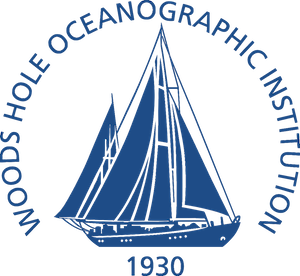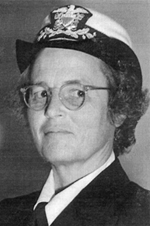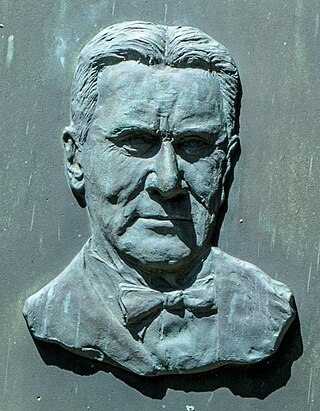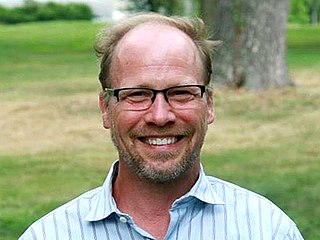
The Woods Hole Oceanographic Institution is a private, nonprofit research and higher education facility dedicated to the study of marine science and engineering.
Perkins School for the Blind, in Watertown, Massachusetts, was founded in 1829 and is the oldest school for the blind in the United States. It has also been known as the Perkins Institution for the Blind.

Mary Sears was a Commander in the United States Naval Reserve and an oceanographer at the Woods Hole Oceanographic Institution (WHOI).

Alfred Clarence Redfield was an American oceanographer known for having discovered the Redfield ratio, which describes the ratio between nutrients in plankton and ocean water. He was a professor of physiology at Harvard University and one of the original staff of the Woods Hole Oceanographic Institution upon its founding in 1930.
William B. Curry is an American oceanographer who is the president and CEO of the Bermuda Institute of Ocean Studies (BIOS). He is known for studying historical climate and ocean circulation. Curry holds a Bachelor of Science in geology from the University of Delaware (1974) and a PhD in geology from Brown University (1980).
Sverdrup Gold Medal Award – is the American Meteorological Society's award granted to researchers who make outstanding contributions to the scientific knowledge of interactions between the oceans and the atmosphere.
Lynne Talley is a physical oceanographer at Scripps Institution of Oceanography known for her research into the large-scale circulation of water masses in the global ocean.
John Crossley Swallow FRS was an English oceanographer who invented the Swallow float, a scientific drifting bottle based on the messages in bottles that shipwrecked sailors hoped would reach inhabited shores, summoning assistance.
Harry Leonard Bryden, FRS is an American physical oceanographer, professor at University of Southampton, and staff at the National Oceanography Centre, Southampton. He is best known for his work in ocean circulation and in the role of the ocean in the Earth's climate.

Joseph Pedlosky is an American physical oceanographer. He is a scientist emeritus at the Woods Hole Oceanographic Institution. Pedlosky was elected to the United States National Academy of Sciences in 1985. He is the author of the textbooks Geophysical Fluid Dynamics, Ocean Circulation Theory, and Waves in the Ocean and Atmosphere: Introduction to Wave Dynamics.

Susan K. Avery is an American atmospheric physicist and President Emerita of the Woods Hole Oceanographic Institution (WHOI) in Massachusetts, where she led the marine science and engineering research organization from 2008–2015. She was the ninth president and director and the first woman to hold the leadership role at WHOI. She is Professor Emerita at the University of Colorado, Boulder (UCB), where she served on the faculty from 1982–2008. While at UCB she also served in various administrative positions, including director of the Cooperative Institute for Research in Environmental Sciences (CIRES), a 550-member collaborative institute between UCB and the National Oceanic and Atmospheric Administration (NOAA) (1994-2004); and interim positions (2004-2007) as vice chancellor for research and dean of the graduate school, and provost and executive vice chancellor for academic affairs. Currently she is a senior fellow at the Consortium for Ocean Leadership in Washington, D.C.

Susan Lozier is a physical oceanographer and the dean of the Georgia Institute of Technology's College of Sciences. Previously, she was the Ronie-Richelle Garcia-Johnson Professor of Earth and Ocean Sciences in the Nicholas School of the Environment at Duke University in Durham, North Carolina. Her research focuses on large-scale ocean circulation, the ocean's role in climate variability, and the transfer of heat and fresh water from one part of the ocean to another.
Kelly Kenison Falkner is an American chemical oceanographer and educator. She is the Director of the National Science Foundation's (NSF's) Office of Polar Programs (OPP). Her work in the position led her NSF colleagues to name the Falkner Glacier, in Victoria Land, Antarctica, after her.
Susan Elizabeth Anne Wijffels is an Australian oceanographer employed by the Woods Hole Oceanographic Institution (WHOI); she formerly worked from the Commonwealth Scientific and Industrial Research Organisation (CSIRO) in Australia. Wijffels specialises in quantifying global ocean change over the past 50 years, including its anatomy and drivers. She is recognised for her international and national leadership of the Global Ocean Observing System. She is regarded as an expert in the Indonesian Throughflow and its role in global climate.

Peter B. de Menocal is an oceanographer and paleoclimatologist. He is the president and director of the Woods Hole Oceanographic Institution, a research facility in Massachusetts.

Heidi Sosik is an American biologist, oceanographer, and inventor based at the Woods Hole Oceanographic Institution.
Sarah Gille is a physical oceanographer at Scripps Institution of Oceanography known for her research on the role of the Southern Ocean in the global climate system.
Elizabeth Kujawinski is an American oceanographer who is Senior Scientist at the Woods Hole Oceanographic Institution, where she works as Program Director of the Center for Chemical Currencies of a Microbial Planet. Her research considers analytical chemistry, chemical oceanography, microbiology and microbial ecology. She is interested in what controls the composition of organic materials in aquatic systems.
Carin Jessica Ashjian is an American biological oceanographer who is an associate scientist at the Woods Hole Oceanographic Institution. She studies how the physical environment influences the distribution of plankton in the Beaufort Sea.
Richard W. Murray, a geologist and oceanographer, is the Deputy Director and Vice President for Research at Woods Hole Oceanographic Institution (WHOI) in Woods Hole, Massachusetts. Murray was previously a professor of earth and environment at Boston University (1992-2019), where he served as Chair of the Department of Earth Sciences (2000-2005), and Director of Boston University's Marine Program (2006-2009).







